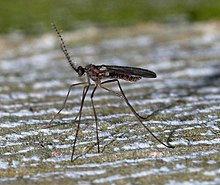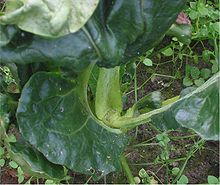Our website is made possible by displaying online advertisements to our visitors.
Please consider supporting us by disabling your ad blocker.
Cecidomyiidae
| Cecidomyiidae Temporal range:
| |
|---|---|

| |
| Scientific classification | |
| Domain: | Eukaryota |
| Kingdom: | Animalia |
| Phylum: | Arthropoda |
| Class: | Insecta |
| Order: | Diptera |
| Suborder: | Nematocera |
| Infraorder: | Bibionomorpha |
| Superfamily: | Sciaroidea |
| Family: | Cecidomyiidae Newman, 1835 |
| Subfamilies | |
| Synonyms | |
| |

Cecidomyiidae is a family of flies known as gall midges or gall gnats. As the name implies, the larvae of most gall midges feed within plant tissue, creating abnormal plant growths called galls. Cecidomyiidae are very fragile small insects usually only 2–3 mm (0.079–0.118 in) in length; many are less than 1 mm (0.039 in) long. They are characterised by hairy wings, unusual in the order Diptera, and have long antennae. Some Cecidomyiids are also known for the strange phenomenon of paedogenesis in which the larval stage reproduces without maturing first.[4][5] In some species, the daughter larvae consume the mother, while in others, reproduction occurs later on in the egg or pupa.[5]
More than 6,650 species and 830 genera are described worldwide, though this is certainly an underestimate of the actual diversity of this family.[6] A DNA metabarcoding study published in 2016 estimated the fauna of Canada alone to be in excess of 16,000 species, hinting at a staggering global count of over 1 million cecidomyiid species that have yet to be described, which would make it the most speciose single family in the entire animal kingdom.[7] A second similar metabarcoding study performed in Costa Rica also found Cecidomyiidae to be the most diverse family of flies, supporting this assertion.[8] A third metabarcoding study in 2023 concluded that Cecidomyiidae are the single most diverse family collected from malaise traps all around the world and are a dominant component of insect diversity, comprising about 20% of all species collected.[9]


- ^ Gagné, Raymond; Jaschhof, Mathias (2017). "A Catalog of the Cecidomyiidae (Diptera) of the World, Fourth Edition" (PDF). Agricultural Research Service, US Department of Agriculture. Retrieved 2018-04-29.
- ^ Mathias Jaschhof (2016). "A review of world Diallactiini (Diptera, Cecidomyiidae, Winnertziinae), with the description of six new genera and seventeen new species". Zootaxa. 4127 (2): 201–244. doi:10.11646/zootaxa.4127.2.1. PMID 27395622.
- ^ "University of California, Riverside". Archived from the original on 2015-09-24. Retrieved 2013-01-04.
- ^ Gagné, Raymond J.; Jaschhof, Mathias (2017). "A Catalog of the Cecidomyiidae (Diptera) of the World, Fourth Edition" (PDF). Agricultural Research Service, US Department of Agriculture. Retrieved 2018-03-27.
- ^ a b Wyatt, I. J. (2009-04-02). "Pupal Paedogenesis in the Cecidomyiidae (Diptera).-I". Proceedings of the Royal Entomological Society of London. Series A, General Entomology. 36 (10–12): 133–143. doi:10.1111/j.1365-3032.1961.tb00259.x.
- ^ R.J. Gagne; M. Jaschof (2021). A Catalog of the Cecidomyiidae (Diptera) of the World (5th ed.). ISBN 978-0-9863941-3-3. Wikidata Q109561625.
- ^ Hebert, Paul D. N.; Ratnasingham, Sujeevan; Zakharov, Evgeny V.; Telfer, Angela C.; Levesque-Beaudin, Valerie; Milton, Megan A.; Pedersen, Stephanie; Jannetta, Paul; deWaard, Jeremy R. (2016-09-05). "Counting animal species with DNA barcodes: Canadian insects". Philosophical Transactions of the Royal Society B: Biological Sciences. 371 (1702): 20150333. doi:10.1098/rstb.2015.0333. ISSN 0962-8436. PMC 4971185. PMID 27481785.
- ^ Borkent, Art; Brown, Brian V.; Adler, Peter H.; Amorim, Dalton De Souza; Barber, Kevin; Bickel, Daniel; Boucher, Stephanie; Brooks, Scott E.; Burger, John; Burington, Z.L.; Capellari, Renato S.; Costa, Daniel N.R.; Cumming, Jeffrey M.; Curler, Greg; Dick, Carl W. (2018-03-27). "Remarkable fly (Diptera) diversity in a patch of Costa Rican cloud forest: Why inventory is a vital science". Zootaxa. 4402 (1): 53–90. doi:10.11646/zootaxa.4402.1.3. ISSN 1175-5334. PMID 29690278. S2CID 13819313.
- ^ Srivathsan, Amrita; Ang, Yuchen; Heraty, John M.; Hwang, Wei Song; Jusoh, Wan F. A.; Kutty, Sujatha Narayanan; Puniamoorthy, Jayanthi; Yeo, Darren; Roslin, Tomas; Meier, Rudolf (2023). "Convergence of dominance and neglect in flying insect diversity". Nature Ecology & Evolution. 7 (7): 1012–1021. Bibcode:2023NatEE...7.1012S. doi:10.1038/s41559-023-02066-0. PMC 10333119. PMID 37202502.
Previous Page Next Page


